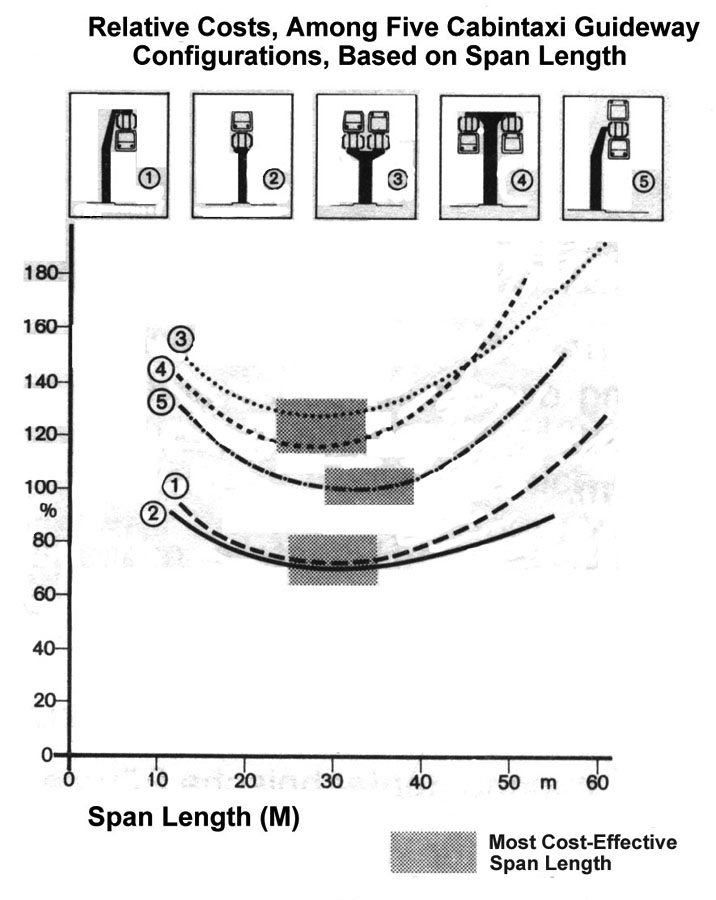The figure above shows a comparison of total Cabintaxi guideway structure costs among five different Cabintaxi system configurations. The relative system costs (shown on the vertical axis) vary by the span distance (shown on the horizontal axis), with the optimum span length of the over-and-under version (#5) representing 100%. The five variations of the Cabintaxi guideway configuration, shown above, were analyzed and the results used to generate the cost curves shown.
Cabintaxi configuration #2 is effectively the same as most of the other PRT concepts. The belief that there is going to be a major cost difference between two well-designed guideway beams carrying effectively the same three passenger vehicle, probably stems from design parameters that start from different imposed requirements.
The relationships in the above figure are based on actual data from a constructed and functioning technology that was approved for installation in the city of Hamburg (development costs were over $250 million in today’s dollars.) The shaded areas represent the range of most cost-effective span lengths for the varying configurations. Assuming that all three passenger single-level PRT systems have the same cost per linear foot of guideway, a loop of single level guideway, where a return path is the key reason for the loop, costs 40% - 60% more than an over-and-under configured system through the same area. This clearly is dependent on the area that needs the connections, but in almost all cases that we have come across, the interconnection of activity nodes (the reality in the real urban world) vs. a ubiquitous grid, speak to significant improvements in service at lower cost for the over-and-under system configuration compared to single-level configurations.
The ability to go in two directions from every station is a major benefit. With just a quick comparison to the system laid out for Kungens Kurva (as a quick example of an available geography but without knowledge of project details) Cabintaxi could give effectively the same coverage throughout their planned service area, and add nearly a second area of coverage of equal size on the opposite side of the expressway, using four kilometers less of structure for the total over-under, single-loop system. This doubles the service area with 8 km of single beam bi-directional structure vs. the given service area utilizing 12 km of single-beam one-directional structure.
The structure costs of 8 km of over-and-under (16 route km) vs. 12 km of single level guideway are effectively equal. The number of stations would appear to be able to drop, with the service performance increasing with faster trips providing more direct travel. This is obviously just a quick comparison based on experiences that we have had, but I have little doubt that a detailed analysis would bear out advantages of over-and-under.
The advantages that the over-and-under guideway configuration brings for urban application is significant, and deserves more consideration when PRT planning is undertaken. I have heard many individuals that support the desire for improve transportation dismiss the over-and-under configuration as some strange thing the Cabintaxi development team did, even thought creation of the Cabintaxi technology was by far the most thorough in the history of urban transit development. The fact that we had the over-running system, the under-running system, and the over-and-under, and chose to lead with the over-and-under, is ignored. We had, and have, all the data that current system developers are now trying to develop for their own systems, from effectively three different functioning configurations, and from that real completed development, the over-and-under configuration has always been the most cost-effective for large urban applications. Application planning using the over-and-under configuration requires a dramatically different way of thinking that does not come intuitively. If you do not have the data it is hard to make such comparisons, but, even though it is all documented by the US and German governments, I rarely find a person that has taken the time to obtain and review the available material.
The document title is, "Development/Deployment Investigation of Cabintaxi/Cabinlift System" UMTA-MA-06-0067-77-02, US Department of Transportation Systems Center, December 1977 (probably available from either the Northwestern University or University of California at Berkeley, transportation libraries).
Marsden Burger, Cabintaxi Corporation
Last Modified: July 16, 2013
